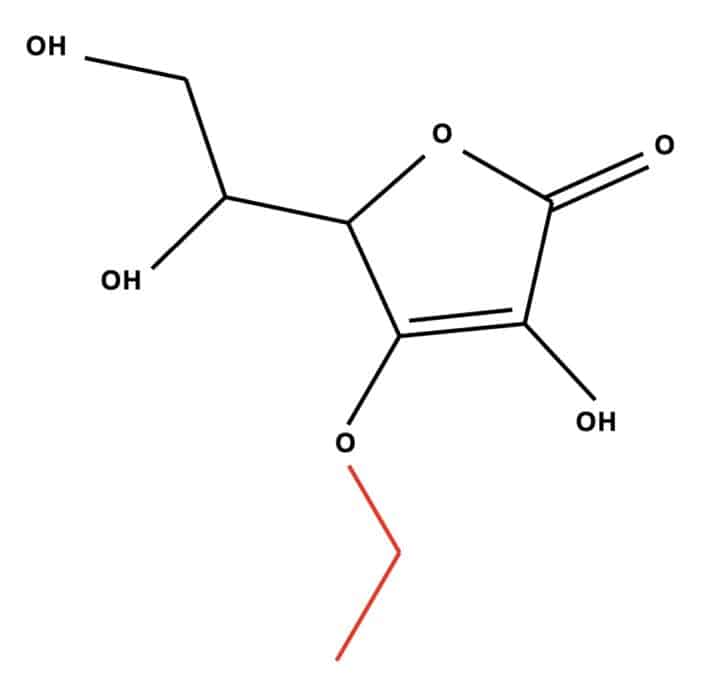3-O-Ethyl Ascorbic Acid

Vitamin C is extensively studied and recognized as one of the most researched vitamins. It functions as a potent antioxidant, reducing wrinkles, combating bacterial infections, and playing a crucial role in collagen formation. However, its inherent instability has led to the increased use of 3-O-Ethyl Ascorbic Acid (EA) in cosmetic formulations. EA, a derivative of ascorbic acid, is renowned for its stability among ascorbic acid derivatives.
So, what exactly is 3-O-Ethyl Ascorbic Acid?
3-O-Ethyl Ascorbic Acid is a highly stable and water-soluble form of vitamin C. It is synthesized by modifying ascorbic acid, attaching an ethyl group to the third carbon position. This modification significantly enhances the molecule’s stability and improves its skin penetration compared to pure vitamin C, which is prone to rapid degradation.
EA shares similar properties with pure vitamin C (ascorbic acid) but exhibits superior stability and reduced susceptibility to oxidation. Oxidation is a process that can compromise the stability of vitamin C, resulting in discoloration and unpleasant odor in cosmetic products. By utilizing 3-O-Ethyl Ascorbic Acid, this issue can be mitigated due to its enhanced resistance to oxidation.
Once 3-O-Ethyl Ascorbic Acid permeates the skin, it undergoes conversion or metabolism into vitamin C. The acid boasts numerous beneficial properties and demonstrates impressive efficacy in the realm of cosmetics.
The effects of 3-O-Ethyl Ascorbic Acid
3-O-Ethyl Ascorbic Acid serves as an exceptional antioxidant and scavenger of free radicals. It not only shields the skin from damage caused by sun exposure but also aids in repairing existing skin damage. The compound facilitates improved collagen synthesis, contributes to wrinkle reduction, and exhibits skin brightening properties, as evidenced by clinical studies. Due to its excellent hydrophilic and lipophilic properties, EA is swiftly and readily absorbed by the skin. Once inside, its anti-inflammatory and antioxidant effects can optimally unfold in the epidermis, aiding in the combat against acne-causing bacteria.
Key cosmetic benefits include:
- Skin whitening: 3-O-Ethyl Ascorbic Acid helps enhance the appearance of dark spots, hyperpigmentation, and uneven skin tone. It inhibits the production of melanin, the pigment responsible for skin color.
- Anti-aging properties: EA acts as a powerful antioxidant, neutralizing free radicals that contribute to premature skin aging. Additionally, it stimulates collagen production, a vital protein for skin elasticity and firmness.
- UV damage protection: EA safeguards the skin against the harmful effects of UV radiation, assisting in the reduction of sun damage and lowering the risk of skin cancer.
- Anti-inflammatory effects: EA possesses soothing and anti-inflammatory properties, making it beneficial for treating skin irritation, redness, and inflammation.
This vitamin C derivative is perfect for your cosmetics. Together with Cosmacon you can develop your product, and that will surely be the successful start to build your own brand.
Antioxidant and skin whitening
In addition, 3-O-Ethyl Ascorbic Acid makes the complexion look firmer and plumper. It is not only slightly lightened, so that annoying spots almost disappear, but also gets a very subtle and beautiful glow. The lightening effect is achieved by inhibiting the activity of tyrosinase and preventing the synthesis of melanin. Thus, EA is one of the most stable and effective forms of ascorbic acid around. It is also extremely gentle and well-tolerated; there is usually no irritation of the skin or eyes. In the body, the ethyl group is removed and the vitamin C is returned to its natural form. In this way, EA retains all the benefits of vitamin C, such as antioxidant activity and collagen synthesis.
In addition, it is even more effective in reducing melanin production after UV exposure. It even has some additional effects not observed with pure ascorbic acid, such as promoting nerve cell growth or reducing chemotherapy damage. Finally, the slower release also ensures that hardly any skin irritating effects are observed when using this vitamin C derivative.
Comparison of skin lightening efficacy of different vitamin C derivatives:
Tested substance
- Ascorbic acid: 0.1 concentration: 70%*
- Magnesium ascorbyl phosphate 0.1 concentration: 20%*
- Ascorbyl glucoside 0.1 concentration: 20%*
- EA 0.1 concentration: 80%*
- EA 0.01 concentration: 40%*
* Inhibition of UV-induced DHICA melanization (%): DHICA (5,26-dihydroxyindole-2-carboxylic acid) is an intermediate product in melanin biosynthesis.
Fact Sheet – 3-O-Ethyl Ascorbic Acid
INCI: 3-O-3-O-Ethyl Ascorbic Acid
CAS number: 86404-04-8
EINECS Number: 617-849-3
Description: is a particularly stable derivative of vitamin C
Appearance: a crystalline white powder
Stability: at a pH between 5.5 and 7.0
Solubility: soluble in water
Melting point: 110 to 115 degrees Celsius
Molecular formula: C8H12O6
Effect: antioxidant, brightening, skin caring, anti-inflammatory
Fields of application: Anti-aging products, acne treatment, skin whitening care products.
3-O-Ethyl Ascorbic Acid as an active ingredient for innovative cosmetic formulations
3-O-Ethyl Ascorbic Acid is not only suitable for daily skin care, but also lends itself very well to the care of nails and hair, as it has a positive influence on their growth. The active ingredient nourishes and strengthens, but at the same time has a rejuvenating effect and can slow down the aging process to a certain extent. In addition, EA is recommended for the treatment of acne, because it can accelerate and support the healing of inflammation. Finally, the vitamin C derivative is also valued for its depigmenting and lightening properties. Thus, it can reduce skin discolorations (for example, age spots or freckles) and protect against the development of new discolorations.
Sources:
Antioxidant Compounds from Microalgae: A Review.; Coulombier N, Jauffrais T, Lebouvier N.Mar Drugs. 2021 Sep 28;19(10):549
Natural Cosmeceutical Ingredients for the Management of Hyperpigmentation in Hispanic and Latino Women.; Murphy MJ, Dow AA.J Clin Aesthet Dermatol. 2021 Aug;14(8):52-56.
The Anti-Ageing and Whitening Potential of a Cosmetic Serum Containing 3-O-ethyl-l-ascorbic Acid.; Zerbinati N, Sommatis S, Maccario C, Di Francesco S, Capillo MC, Rauso R, Herrera M, Bencini PL, Guida S, Mocchi R.Life (Basel). 2021 Apr 29;11(5):406
Seven cases of allergic contact dermatitis caused by cosmetics containing 3-O-ethyl-L-ascorbic acid.; Suzuki K, Futamura K, Nishimura A, Matsunaga K, Yagami A.Contact Dermatitis. 2022 Jan 7.